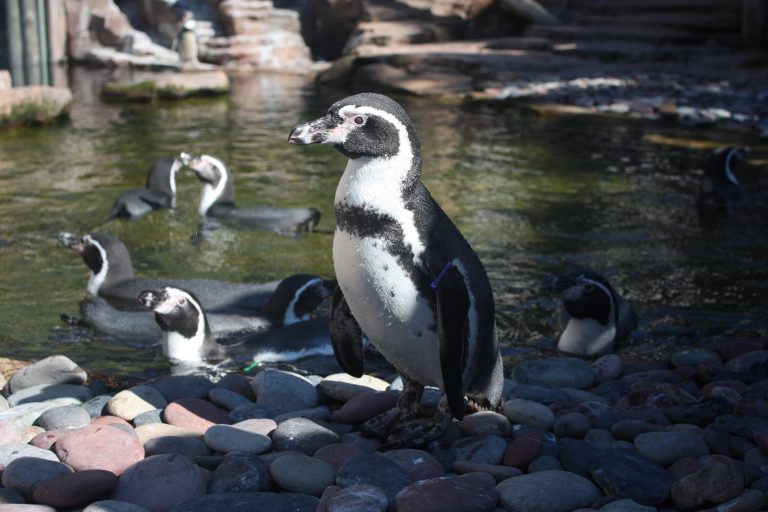Kingdom: Animalia
Phylum: Chordata
Class: Aves
Order: Sphenisciformes
Family: Spheniscidae
Humbolt Penguins
Range: Along the coast of Peru and Chile
Habitat: Rocky mainland shores, especially near cliffs, or on coastal islands
Conservation Status: Endangered/Vulnerable
Scientific Name: Spheniscus humboldti
Humboldt penguins are social animals, living in relatively large colonies, known as rookeries, where communication is important. Each penguin has a unique voice which allows its mate and offspring to recognize it. Humboldt penguins have a body made to swim. Using their strong wings, they “fly” underwater, usually just below the surface, at speeds of up to 20 miles per hour. They have a supraorbital gland which enables them to drink salt water in addition to fresh water. The gland withdraws excess salt from the penguins’ blood and excretes it in a concentrated solution which dribbles down the bill. Humboldt penguins can breed at any time of the year. Nests are made in caves, cracks or holes and occasionally in more open sites such as rocky shore.
Humboldt penguins can blush. When they get too hot (it can get up to 108 degrees (F) where they live) they have to avoid over-heating. So they flush pink on their face, wings and feet. This sheds body heat by sending blood to the bare part of their bodies. Throughout the day, Humboldts engage in a vital activity: they preen their feathers. They gather oil from their preening gland and apply it to their feathers and the edges of the flippers. This keeps their feathers waterproof, helping insulate the birds from the cold. Like all penguins, a Humboldt’s black and white color helps camouflage it when it’s in the sea. When seen from below, its white belly blends with the light cast on the ocean surface; and when seen from above, its black back blends with the darkness of the ocean depths.
The primary reason Humboldt penguins are endangered is due to humans. The guano in which Humboldt penguins make their nests is a valuable fertilizer used in agriculture. Humans disrupt the penguins by removing and destroying the guano during nesting season. Humboldt penguins also must compete with the offshore fishing industry in Peru and Chile and they often get caught in fishing nets and drown. Other threats to Humboldt penguins are oil spills, humans collecting their eggs for food, disturbances caused by tourists and researchers, and introduced predators such as rats, cats and dogs.
Scovill Zoo received 10 Humboldt penguins in 2013. They came from St. Louis, Philadelphia, Santa Barbara, Seattle, Syracuse, and Sedgwick County, Kansas. In 2017 the zoo received two more penguins from Syracuse bringing our total to 13; 7 males and 6 females.

